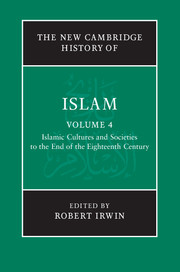Book contents
- Frontmatter
- Introduction
- PART I RELIGION AND LAW
- 1 Islam
- 2 Sufism
- 3 Varieties of Islam
- 4 Islamic law: history and transformation
- 5 Conversion and the ahl al-dhimma
- 6 Muslim societies and the natural world
- PART II SOCIETIES, POLITICS AND ECONOMICS
- PART III LITERATURE
- PART IV LEARNING, ARTS AND CULTURE
- Glossary
- Bibliography
- Index
- References
5 - Conversion and the ahl al-dhimma
from PART I - RELIGION AND LAW
Published online by Cambridge University Press: 28 March 2011
- Frontmatter
- Introduction
- PART I RELIGION AND LAW
- 1 Islam
- 2 Sufism
- 3 Varieties of Islam
- 4 Islamic law: history and transformation
- 5 Conversion and the ahl al-dhimma
- 6 Muslim societies and the natural world
- PART II SOCIETIES, POLITICS AND ECONOMICS
- PART III LITERATURE
- PART IV LEARNING, ARTS AND CULTURE
- Glossary
- Bibliography
- Index
- References
Summary
The problem
The word islām means ‘submission’, ‘submitting’, and conversion to Islam involves nothing more, at base, than submitting oneself to God. It has consequences – legal, fiscal and especially social – in different contexts, but its religious aspect consists of just the formal recognition of the one God and of Muḥammad as His messenger. Reciting the formula lā ilāha illā Allāh, Muḥammad rasūl Allāh is enough. The act of coming to Islam is thus very simple. The worldwide spread of a faith that at first was exclusively that of the inhabitants of the Arabian Peninsula was, however, much more complex as Islam came for centuries also to mean an empire created and at first largely ruled over by Arabs and a culture dominated by Islam: ‘civilization and Islam went together’.
Between 632 and about 1500 the great majority of the people between the Atlantic and India, and many beyond, converted to Islam. Who did it, when, where, how and above all why? What was the meaning of conversion, for converts and for those around them, their new co-religionists and their former ones? Can we measure the degree or rate of conversion in different societies and areas of the Islamic world? Did it happen all at once or over a longer period of time? Was it voluntary or did converts change their faith under compulsion? What happened to those left behind, those who did not undergo conversion?
- Type
- Chapter
- Information
- The New Cambridge History of Islam , pp. 184 - 208Publisher: Cambridge University PressPrint publication year: 2010
References
- 2
- Cited by

